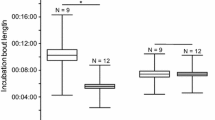Summary
The use of green nesting material is widespred among birds. Recent evidence suggests that birds use secondary chemicals contained in green plants to control ectoparasites. We manipulated green nesting material and ectoparasites of European starlings (Sturnus vulgaris) to test two hypotheses: (1) ectoparasites adversely affect prefledging survival and morphometrics or postfledging survival, and (2) green nesting material ameliorates the effects of ectoparasites. We recorded fat score, numbers of scabs, tarsal length, body mass, and hematocrit level on each nestling 17 days after hatching. We also fitted each nestling with unique patagial tags and resighted the starlings for 6–8 weeks after fledging to estimate survival and sighting rates. Nests devoid of green nesting material and dusted with the insecticide, carbaryl, had fewer high ectoparasite infestations, and nestlings had significantly lower scab scores, and significantly higher body masses than nestlings in undusted boxes. However, there was no difference in postfledging survival between birds from carbaryl-treated and undusted nests. There also was no difference in prefledging survival and morphometrics or postfledging survival between nestlings from boxes with and without green nesting material. These results do not support the hypothesis that starlings use green nesting material to control nest ectoparasites. We suggest an alternative hypothesis; green nesting material is used for mate selection or pairbonding in the starling.
Similar content being viewed by others
References
Ali S, Ripley SD (1974) Handbook of the Birds of India and Pakistan, vols. 1–10. Oxford, Oxford University Press
Anderson DR, Burnham KP (1976) Population ecology of the mallard. VI. The effect of exploitation on survival. U.S. Fish and Wildlife Service Resource Publication 128
Arendt WJ (1985) Philornis ectoparasitism of pearly-eyed thrashers. I. Impact on growth and development of nestlings. Auk 102:270–280
Boyd EM (1951) A survey of parasitism of the starling Sturnus vulgaris L. in North America. J Parasitol 37:56–84
Brown C, Brown MB (1986) Ectoparasitism as a cost of coloniality in cliff swallows (Hirundo pyrrhonota). Ecology 67:1206–1218
Brownie C, Anderson DR, Burnham KP, Robson DS (1985) Statistical inference from band recovery data — a handbook. 2nd ed. U.S. Fish and Wildlife Service Resource Publication 156
Brownie C, Hines JE, Nichols JD (1986) Constant-parameter capture-recapture models. Biometrics 42:561–574
Carothers AD (1973) The effects of unequal catchability of Jolly-Seber estimates. Biometrics 29:79–100
Carothers AD (1979) Quantifying unequal catchability and its effect on survival estimates in an actual population. J Anim Ecol 48:863–869
Clark L, Mason JR (1985) Use of nest material as insecticidal and anti-pathogenic agents by the European starling. Oecologia 67:169–179
Clark L, Mason JR (1987) Olfactory discrimination of plant volatiles by the European starling. Anim Behav 35:227–235
Clark L, Mason JR (1988) Effect of biologically active plants used as nest material and the derived benefit to starling nestlings. Oecologia 77:174–180
Cummings JL (1987) Nylon fasteners for attaching leg and wing tags to blackbirds. J. Field Ornithol. 58:265–269
Feare C (1984) The starling. New York, Oxford Univ Press
Gold CS, Dahlsten DL (1983) Effects of parasitic flies (Protocalliphora spp.) on nestlings of mountain and chestnut-backed chickadees. Wilson Bull 95:560–572
Helms CW, Drury WH Jr. (1960) Winter and migratory weight and fat field studies on some North American buntings. Bird-Banding 31:1–39
Hill EF (1979) Cholinesterase activity in Japanese quail dusted with carbaryl. Lab Anim Sci 29:349–352
Johnston RF, Hardy JW (1962) Behavior of the purple martin. Wilson Bull 74:243–262
Jolly GM (1965) Explicit estimates from capture-recapture data with both death and immigration-stochastic model. Biometrika 52:225–247
Jolly GM (1982) Mark-recapture models with parameters constant in time. Biometrics 38:301–321
Kahl MP Jr. (1972) Comparative ethology of the Ciconiidae. The wood storks (genera Mycteria and Ibis). Ibis 114:15–29
Kessel B (1957) A study of the breeding biology of the European starling (Sturnus vulgaris L) in North America. Am Midl Nat 58:257–331
Krementz DG, Nichols JD, Hines JE (1989) Postfledging survival of European starlings. Ecology 70:646–655
Meyers LE (1922) The American swallow bug, Oeciacus vicarius Horvath (Hemiptera: Cimicidae). Parasitology 20:159–172
Moss WW, Camin JH (1970) Nest parasitism, productivity, and clutch size in purple martins. Science 168:1000–1003
Pollock KH (1981) Capture-recapture models: a review of current methods, assumptions and experimental design. Stud Avian Biol 6:426–435
Pollock KH, Hines JE, Nichols JD (1985) Goodness-of-fit tests for open capture-recapture models. Biometrics 41:399–410
Pollock KH, Nichols JD, Brownie C, Hines JE (1990) Statistical inference for capture-recapture experiments. Wildl Monogr 107:1–97
Powlesland RG (1977) Effects of the haematophagous mite, Ornithonyssus bursa on nestling starlings in New Zealand. New Zealand J Zool 4:85–94
Seber GAF (1965) A note on the multiple-recapture census. Biometrika 52:249–259
Seber GAF (1982) The estimation of animal abundance and related parameters. 2nd ed. New York, MacMillan Publ. Co
Stromborg KL, Grue CE, Nichols JD, Hepp GR, Hines JE, Bourne HC (1988) Postfledging survival of European starlings exposed as nestlings to an organophosphorous insecticide. Ecology 68:590–601
Tucker RK, Crabtree DG (1970) Handbook of toxicity of pesticides to wildlife. In: U.S. Fish and Wildlife Service Research Publication 84, pp. 11–123
van Noordwijk AJ, van Balen JH (1988) The great tit, Parus major. In: Reproductive Success (TH Clutton-Brock, ed.) Chicago, University of Chicago Press, pp. 119–135
Walter G, Hudde H (1987) Carnus hemapterus (Milichiidae, Diptera), an ectoparasite of nestlings. J Ornithol 128:251–255
Wasylik A (1971) Nest types and abundance of mites. Ekol Pol 19:689–699
Wimberger PH (1984) The use of green plant material in bird nests to avoid ectoparasites. Auk 101:615–618
Author information
Authors and Affiliations
Rights and permissions
About this article
Cite this article
Fauth, P.T., Krementz, D.G. & Hines, J.E. Ectoparasitism and the role of green nesting material in the European starling. Oecologia 88, 22–29 (1991). https://doi.org/10.1007/BF00328399
Received:
Accepted:
Issue Date:
DOI: https://doi.org/10.1007/BF00328399



